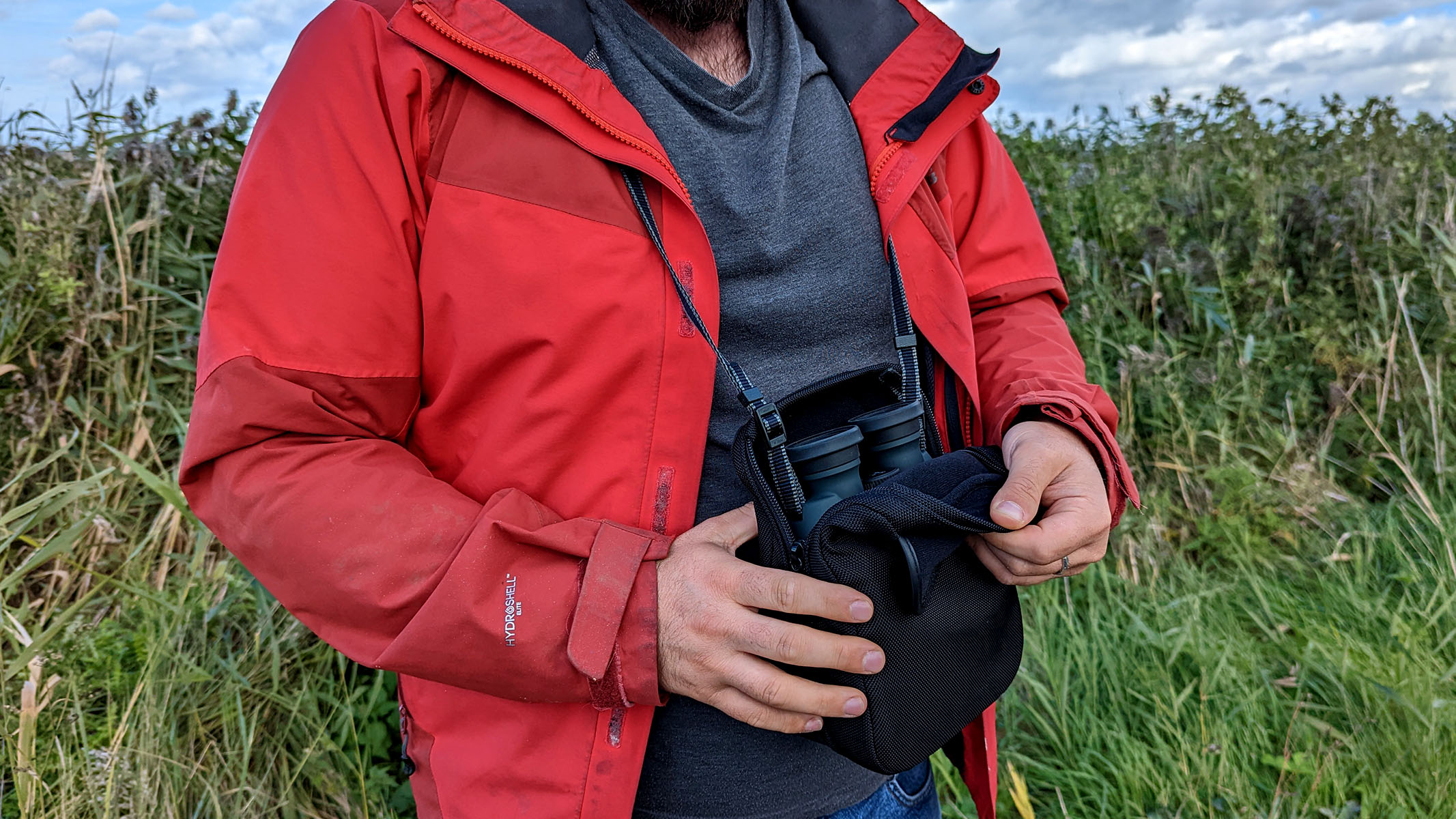Live Science Verdict
We’re big fans of the Canon 10x32 IS binoculars due to their phenomenal optical clarity, aided by image stabilization which comes in two modes and their compactness. However, their predisposition to fogging lets them down.
Pros
- +
Extremely clear and sharp optics
- +
Image stabilization steadies views
- +
Rugged build quality
Cons
- -
Lenses fog when changing locations
- -
Noticeable chromatic aberration
- -
Incredibly expensive binoculars
Why you can trust Live Science
Who are the Canon 10x32 IS binoculars for? They’ve got a high price tag, magnify the same as many others that are much cheaper and their objective lens size isn’t anything to write home about. So what’s so special about them? Well, that question is answered as soon as you hold them up to your eye.
Canon is using a Porro II prism optics design that includes field flattener lens elements in order to produce an even and flat view through the binoculars. That doesn’t really mean anything to the uninitiated until held up to the eye and then it’s immediately apparent how important this is for improving the view. It’s as if our eyeballs were given zoom powers, able to view the world through the binoculars as if they weren’t really there. That’s helped by the apparent field of view which sits at 55.3 degrees.
This is what elevates the Canon 10x32 IS into the ranks of the best binoculars out there. But there’s more to these binoculars than just the view through the eyepieces, so let’s take a look at their design quality.
Canon 10x32 IS binocular: Design
- Camouflage green coloring is inconspicuous in wild places
- Legitimately heavy but light enough to carry round the neck
- Carry bag appropriately protective but the design could be improved
Flashed in an attractive, camouflaging earthy green, the Canon 10x32 IS binos give a good grip and reflect little light thanks to the matte finish. The eyepiece adjustment is unconventional when compared to many other binoculars on the market in that they pivot independently of the optical tubing assembly itself, presumably due to the in-built image stabilization mechanisms inside.
The focusing wheel is smooth and accurate and the image stabilization (IS) buttons atop the device sit just under where fingers naturally rest making them easy to operate. You’ll notice that there are two buttons for IS which seems a bit baffling to new owners since you (seemingly) can’t decipher any difference between stabilization operation when one button or the other is pressed, but there is a difference which we’ll explain later.
For their magnification and size of the objective lenses, this pair of binoculars is surprisingly weighty at 27.5 oz (780g) without batteries (which you must add if you plan on using the stabilization). They aren’t uncomfortable to wear all day though, but we think that the neck strap should be upgraded for those who like to go out and observe regularly for extended periods.
The carry bag these binoculars ship with is adequate for housing them and gives adequate protection when hiking with binoculars, especially when climbing over styles and fences that users are likely to bump the binoculars on. However, there’s one small area we think the binoculars could be improved upon. Instead of leashing the neck strap around the binoculars themselves and then placing them in the protective carry bag, we believe an additional option of attaching the neck strap to the bag itself would be beneficial. Multiple times we found ourselves having to hold the carry bag between our knees while using the binoculars to avoid laying it on the muddy ground. Some other binocular manufacturers do this, so we’re unsure of Canon’s reasoning not to include carry straps on the bag.
Get the world’s most fascinating discoveries delivered straight to your inbox.
Canon 10x32 IS binocular: Performance
- Outstanding optical clarity with great views
- Image stabilization is smooth and efficient
- Some chromatic aberration but doesn't affect use
The Canon 10x32 IS binoculars are one of, if not the best binoculars we’ve ever had the pleasure of using. They don’t come without their gripes, which we’ll talk more about shortly, but to overstate how clear and full the view through these binoculars is would be tricky. The Super Spectra coating does a great job of removing unwanted flaring and ghosting which shows when panning near bright points like when the sun reflects off water or looking towards street lights in low light or at night time.
Image Stabilization is excellent and steadies the views through the binoculars so well that even when viewing static or moving subjects the subject is held steady in the frame. Two IS modes give control over stabilizing a fixed point or a moving subject like a flying bird. It can be a little tricky to navigate between the two with the two buttons on top of the binoculars but a quick read through the manual will sort out any confusion.
Held steady over one spot we noticed it took a great deal of shaking to get the binoculars to stir away from this point and this allowed us to study several species of birds. Due to the clarity of the lenses and the IS we were able to correctly identify several birds that normally we’d have to move closer to do on another pair of 10x32 binoculars.
They work great at night as well and Jupiter was visible with two or three moons just seeping into view. Planetary observing isn’t really the Canon 10x32 IS’s strong suit though, but larger constellations such as Orion were observable, giving a good opportunity to study Orion’s sword on clear nights. Lunar observations were bright and sharp also but the limitation of 10x magnification meant that either a longer pair of binoculars (such as the Celestron SkyMaster Pro 20x80) or a telescope with a dedicated powerful eyepiece would be better suited.
We would like to see improvements to the chromatic aberration (especially purple color fringing) present in these binos. Though, we do think that it is much more obvious to see through these binoculars because they are so bright and clear. Also, these binoculars aren’t Nitrogen purged which means they’ll fog up if you flit between cold and hot locations. We became quite frustrated when spotting a rare songbird early one morning having just left the house, only to lose sight of it due to internal fogging. It’s surprising Canon haven’t purged them, considering the price tag, but there are methods we can use to limit the fogging so it’s not a deal breaker.
Canon 10x32 IS binocular: Functionality
- Clever auto shut-off design for Image Stabilization saves battery
- Adjustable eyecups for eyeglasses wearers
- IS modes can be confusing to operate
Where these binoculars really shine is in their ability to function intelligently. Most users will either have the binoculars attached via the neckstrap or use them at a table, perhaps in a hide or at home. The binos take two AA batteries that power the stabilization which, of course, would drain quickly if the IS is left on continuously. Fortunately, Canon has thought of this and built in a mechanism to automatically switch off the stabilization on the binoculars if they’ve been stored vertically (objective lenses aiming at the ground) for 10 seconds or more. That means, after observing a given subject and returning the binoculars to the vertical position when dangling from the neck, or placed on a table or other surface, the binoculars won’t drain the battery if you forget to turn off the IS.
The image stabilization has two modes: one gives a steady view when looking over a general area (general IS) and the other is better at locking onto one point of focus and keeping things rock-solid (POWERED IS). There is a little finger dance you’ll have to become accustomed to in order to operate the two modes with efficiency and reading the manual is best to understand how to operate between the two as there are several different ways to engage the modes. We appreciate the comprehensiveness and flexibility in how to access the modes but feel it’s overcomplicated and that a switch, instead of two buttons, would perform better overall.
The eyecups are adjustable for spectacles wearers by flipping back the outer rubber trim which reduces the distance between the eyepiece lenses and the eyes, allowing for eyeglasses to sit in between. This isn’t quite as precise as some other binoculars such as models from Celestron which allow screw adjustment for the eyecups, but they appear to perform well enough to vary between users.
Should I buy the Canon 10x32 IS binoculars?
Whether you should buy this pair of binoculars depends on a few things. Overall, we would say that they are fantastic binoculars and we thoroughly enjoyed using the image stabilization. If you have used a pair of binoculars with IS before then your jaw will hit the floor with these as they are a game-changer. That said, there’s a frustrating amount of color fringing and fogging due to the lack of Nitrogen purging, which, for the money, we’d really expect to see addressed at this price level.
If the price doesn’t put you off, you won’t regret buying the Canon 10x32 IS binoculars and we found them continuously strapped to our neck for the two weeks we used them. We’d heartily recommend them but can’t give full marks to Canon on this pair due to the aforementioned limitations.
If this product isn't for you
It’s true that for many these binoculars will be out of budget, so instead we’d recommend taking a look at the Celestron Nature DX 12x56 which preserves great optical clarity but lack the image stabilization, wide apparent field of view and ultra sharpness of the Canons but costs nearly five times less and also come in an attractive matte green coloration.
For deep sky astronomy observations, we’d edge you towards the Celestron SkyMaster Pro 20x80 binoculars which have a huge magnification and massive objective lenses to drink in the light from distant stars. They’re much bigger though and nearly twice the weight of the Canon’s reviewed here. However, they too cost about four and a half times less. They even have a built-in RSR for attaching them to a tripod (a must) and affixing a red dot finderscope like you would a telescope.
If something a little smaller is preferable, then take a look at a more compact pair of binoculars such as the Nikon 10x50 Aculon A211 which are also a Porro prism design but feature BaK-4 glass for superior optical clarity.

Jase Parnell-Brookes is the Managing Editor for e-commerce for Live Science and Space. Previously the Channel Editor for Cameras and Skywatching at Space, Jase has been an editor and contributing expert across a wide range of publications since 2010. Based in the UK, they are also an award-winning photographer and educator winning the Gold Prize award in the Nikon Photo Contest 2018/19 and named Digital Photographer of the Year in 2014. After completing their Master's degree in 2011 and qualifying as a teacher in 2012, Jase has spent the last two decades studying and working in photography and publishing in multiple areas, and specializes in low light optics and camera systems.




